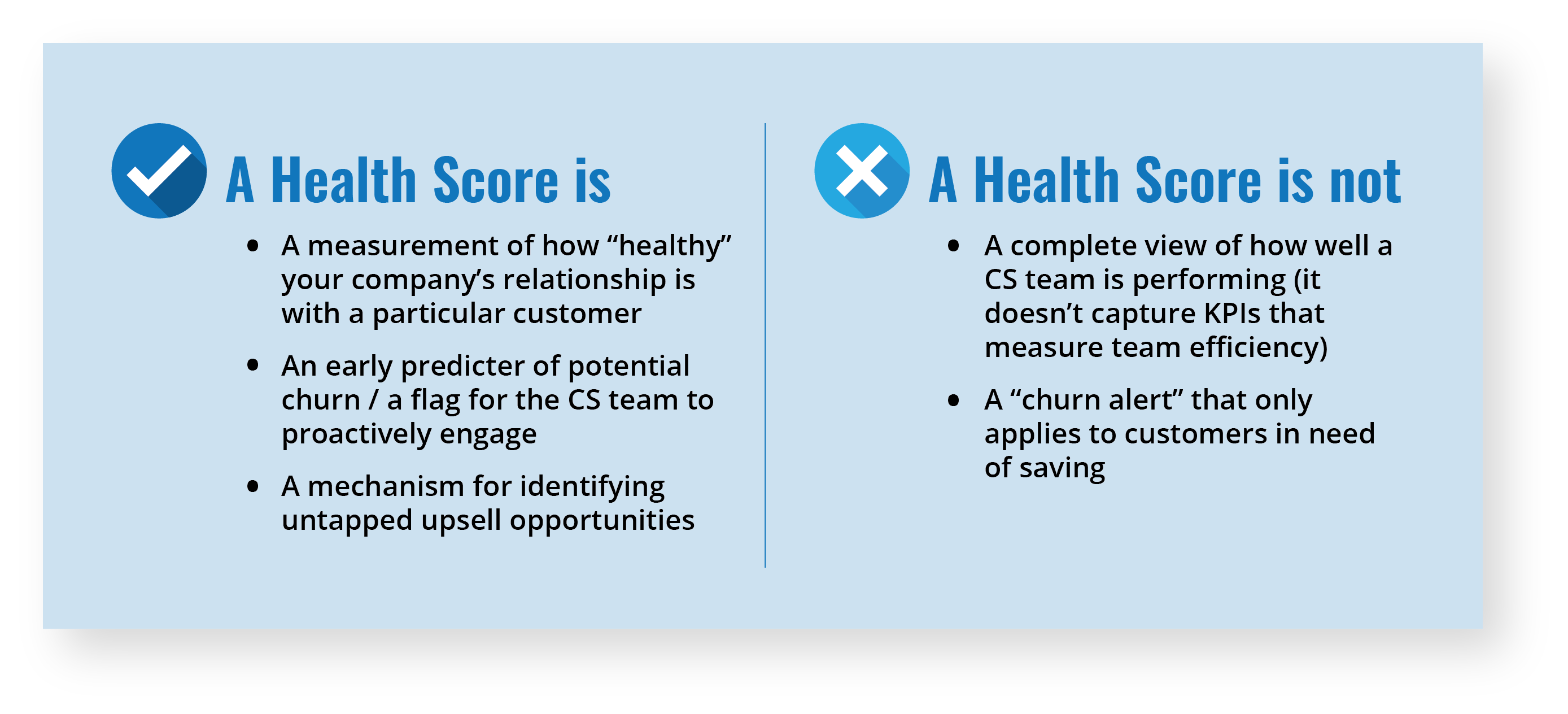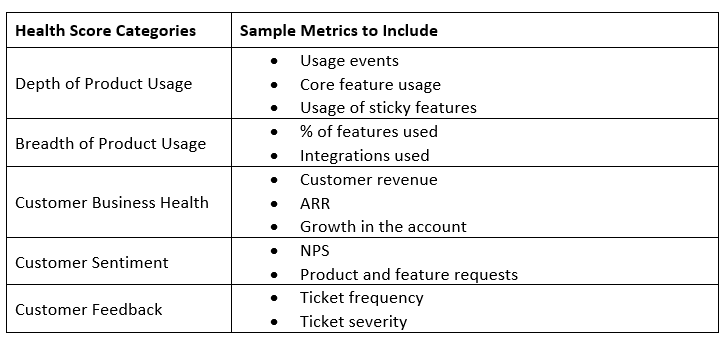Powering Growth with Customer Health Scores Part 1
Part 1: How to Calculate your Customer Health Score
Tracking your Customer Health Score is important to your company’s success because it helps ensure you are providing excellent service, can improve customer retention, and can increases upsell potential—all while enabling your customers to turn into product champions.
In this three-part blog series, Mainsail Partners’ John Mathew, Meg Heinz and Matt Solomon discuss how to calculate Customer Health Scores and how to deploy them across your organization.
What is a Customer Health Score?
A Customer Health Score is a consolidated metric that helps Customer Success and Account Management teams monitor at-risk accounts and identify growth opportunities. Simply put, it’s a quantitative metric that measures the strength of your relationship with a customer.
In its ideal form, a Customer Health Score can help predict customer outcomes and future behavior.
Typically, Customer Health Scores are represented by a score of 0-100, assigned to a customer based on the relative weighting of multiple metrics spanning product usage, customer sentiment and customer engagement metrics. The final score can be used to classify customers as “healthy” or “at-risk”.


Why is a Customer Health Score important?
Health scores provide a holistic and digestible look into your customer base. At an organizational level, they enable you to understand how your customers are engaging with your product at any given time. At a tactical account level, they can provide teams with a perspective on when and how to best engage with customers.
A common misconception is that a health score is solely used to flag customers that may be churn risks—but a health score can also capture which customers value the product most or get the biggest ROI. These cohorts of “healthy” customers identified by health scores can be prime candidates for upselling or cross-selling new products and are ideal candidates for referrals and case studies down the line.
Health scores can also help determine which customers are lukewarm about your product. Identifying these “moderately healthy” customers can fuel an outreach campaign to help move customers from lukewarm to power users.
How to determine a Customer Health Score
- First, involve the right stakeholders: To ensure your score captures the full customer picture, involve customer-facing leaders responsible for retention and upsell, as well as product leaders who have a strong pulse on your customers’ needs and voices.
- Then, define “healthy” and “at-risk” customers: This step may seem premature prior to calculating and reviewing your Customer Health Score, but receiving anecdotal feedback about your customers from multiple departments can provide a good starting point for identifying health score metrics.
Step 1: Segment your accounts
Do you have multiple customer tiers or product offerings? Do you service both enterprise and SMB customers? Address these questions before diving into the detail of which metrics belong in your score.
If what defines a “healthy” customer is different on day 1 of that customer’s journey vs. day 90, your metrics should reflect the change in definition. You might segment your health score by:
- Customer Lifecycle: Onboarding stage vs. mature customers
- Account value (ARR): Small vs. large customers
- Product tier: By plan level or account tier
- Geography: By state or region
Step 2: Determine which key metrics to include
Now, let’s decide which metrics belong in your score. This process involves trial and error, but it’s an exercise that will help you learn more about your customer base and gain more clarity on what defines customer health for your company.
If a customer is frequently using your products and likes working with you, they should have a positive score. If they’re dissatisfied and considering leaving, their score should alert you to that risk. Below are a few sample metrics to test. This list is not exhaustive.


Be sure to select dynamic metrics. The true value of a Customer Health Score is its ability to predict customer behavior (e.g., is a customer going to churn? Is a customer likely to buy new products?). Therefore, designing a score by choosing metrics that change week-to-week or month-to-month is key as opposed to picking static, point-in-time metrics that will not change, such as whether a customer received a specific training session.
Step 3: Assign a weight to each metric
We believe the best way to determine which metrics are most important is to compare data from your overall customer base with historically “healthy” customers that have strong net revenue retention, as well as churned customers that have left the platform.
The inclusion of each metric and the relative weighting of each metric can be determined based on where there are large discrepancies between cohorts. Finding the thresholds for each metric (e.g., >4 tier II support tickets in a month means a customer gets 0 points for that metric) can be established through data analysis. Leverage all the data that has been captured in the past to see how each metric influences customer behavior.
Once you have assigned a weight to each metric, you’ll need to define health score bands. Typically, health scores can be categorized by color. For example:
- Green (healthy) = >70
- Yellow (moderately healthy) = 40-70
- Red (at-risk) = <40
The threshold for each bucket should be based on the architecture of your score and how it breaks down across each cohort you had previously tested. Defining thresholds for each health score category is not an exact science, adjust the thresholds for what defines healthy customers by taking a look at your customer base and checking if the healthy customers you identified at the beginning of the process are captured in the correct tiers.
Tips to keep in mind while designing your Customer Health Score
- Keep each metric binary. If customers meet the threshold or requirement for the metric in the score, they should receive all related points. If not, they should receive 0 points. As you develop your health score, you can implement more nuanced scoring.
- Keep it simple. What if there are more than 25 different metrics that have the potential to fit in the score? How do you decide which ones to keep? This is a great problem to have! Try using your churned customer analysis to prioritize the most relevant 3-5 metrics to include. A common issue with health scores in the initial design stage is overcomplication.
- Don’t worry about perfection. Very few health scores can flag 100% of all churned customers or correctly identify all customers that are prime candidates for upselling in the future; there is a solid chance there will be a few “false positives” during the first few months of the health score.
- Monitor closely, iterate often. The goal of a Customer Health Score should not be to create a single set of health metrics that never change. As your company grows, releases new products, and enters new markets, you should change and evolve your health score to match the evolving customer base.
What’s next?
Customer Health Scores have the potential to be an incredibly powerful tool for a company’s strategic planning purposes. At any given moment, they allow you to report on how many accounts or how much ARR is “at-risk” while also identifying which “healthy” customers are prime candidates for upsell—insights that can lead to more accurate forecasting.
So, what’s next?
Part 2 in this Series: Now that you’ve determined which metrics to include in your company’s Customer Health Score, it’s time to integrate the score into your CRM so it can be measured and monitored to help CSMs and leaders maximize customer engagement. READ MORE >>
Part 3 in this Series: Already adopted your Customer Health Score into your business systems? Here’s how to leverage your scores and determine the best outreach strategies to better engage your customers. READ MORE >>
The information herein is based on the author’s opinions and views and there can be no assurance other third-party analyses would reach the same conclusions as those provided herein. The information herein is not and may not be relied on in any manner as, legal, tax, business or investment advice.
Certain information contained in this content piece has been obtained from published and non‐published sources prepared by other parties, which in certain cases have not been updated through the date hereof. While such information is believed to be reliable for the purposes of this content piece, neither Mainsail nor the author assume any responsibility for the accuracy or completeness of such information and such information has not been independently verified by either of them. The content piece will not be updated or otherwise revised to reflect information that subsequently becomes available, or circumstances existing or changes occurring after the date hereof, or for any other reason.
Certain information contained herein constitutes “forward-looking statements,” which can be identified by the use of terms such as “may,” “will,” “should,” “could,” “would,” “predicts,” “potential,” “continue,” “expects,” “anticipates,” “projects,” “future,” “targets,” “intends,” “plans,” “believes,” “estimates” (or the negatives thereof) or other variations thereon or comparable terminology. Forward looking statements are subject to a number of risks and uncertainties, which are beyond the control of Mainsail. Actual results, performance, prospects or opportunities could differ materially from those expressed in or implied by the forward-looking statements. Additional risks of which Mainsail is not currently aware also could cause actual results to differ. In light of these risks, uncertainties and assumptions, you should not place undue reliance on any forward-looking statements. The forward-looking events discussed in this content piece may not occur. Mainsail undertakes no obligation to update or revise any forward-looking statements, whether as a result of new information, future events or otherwise.
No representation, warranty or undertaking, express or implied, is given as to the accuracy or completeness of the information or opinions contained in the enclosed materials by Mainsail and no liability is accepted by such persons for the accuracy or completeness of any such information or opinions. For additional important disclosures, please click here.

